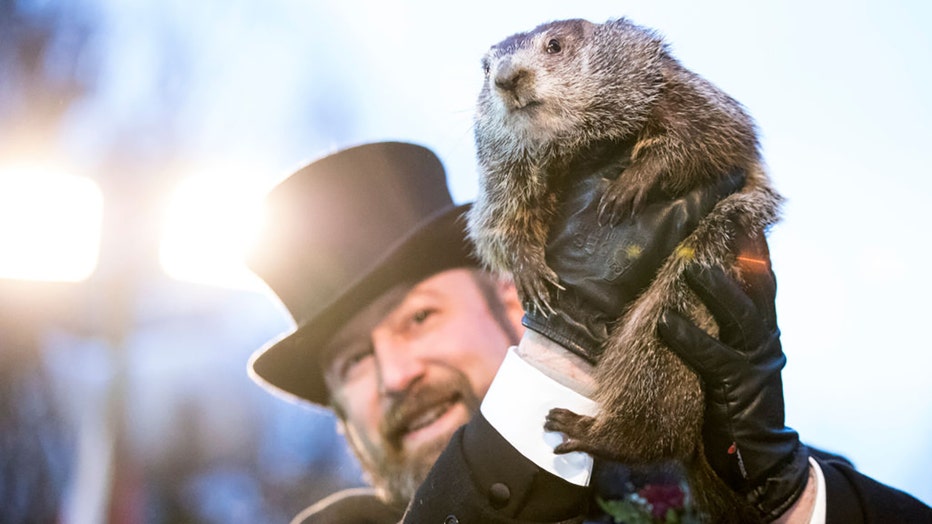Groundhog Day 2024: Punxsutawney Phil makes his winter prediction

NOAA: Is Punxsutawney Phil accurate?
Friday marks Groundhog Day and while many wait to see if Phil will see his shadow, the National Weather Service says the groundhog is wrong slightly more than he is right.
It’ll be an early start to spring, according to Pennsylvania’s most famous groundhog.
Punxsutawney Phil left his burrow on Friday morning and did not see his shadow – predicting an early spring.
Each year on Feb. 2, thousands descend on Gobbler's Knob in Punxsutawney, Pennsylvania, to watch the giant rodent make his annual weather prediction at dawn with the help of his "inner circle" — a group of local dignitaries who are responsible for planning the events, as well as feeding and caring for Phil himself.
RELATED: Where to watch and stream Bill Murray's 'Groundhog Day' movie
"It’s not what I feel, it's what I see and what you hear, so gather round and let me be clear. Atmosphere is a wonderful thing. And we can create our own and the weather it brings," one of Phil’s handlers read from a scroll. "It brings hope for the future and so much more."
According to legend, there will be six more weeks of winter if he sees his shadow. If he doesn’t, spring comes early.

FILE - Punxsutawney Phil is held up by his handler for the crowd to see during the ceremonies for Groundhog day on February 2, 2018 in Punxsutawney, Pennsylvania. (Photo by Brett Carlsen/Getty Images)
About 10,000 people have made their way in recent years to Punxsutawney, where festivities begin in the dead of night and culminate in the midwinter forecast. A bundled-up crowd, some wearing groundhog-themed hats, watched musical performances and fireworks as they waited for sunrise and the appearance of Punxsutawney Phil.
Pennsylvania Gov. Josh Shapiro took the stage before Phil to urge people around the world watching the festivities to come to Punxsutawney next year. Shapiro also announced the famed groundhog is the new official meteorologist for Pennsylvania.
"Punxsutawney is the center of the universe right now, and I love that you’re all here," Shapiro said.
The groundhog tradition is thought to have originated in the 1800s and, over time, has become a staple in America’s culture.
Groundhog Day prediction accuracy
Records kept by the Punxsutawney Groundhog Club show Phil has predicted 107 continued winters and only 20 early springs as of 2024. According to the Stormfax Almanac, that works out to a 39% accuracy rate for Phil.
In the near term, the groundhog’s accuracy rate is slightly better. According to the National Oceanic and Atmospheric Administration, Phil has been right about 40% of the time on average over the past decade.
In 2021, Phil predicted more winter. According to NOAA, his forecast was about half right. February 2021 was the coldest since 1989, but March turned out to be warmer than normal.
Forget the groundhog prediction: 7 animals who will give Punxsutawney Phil a run for his money
Groundhog Day origin: History of the annual tradition
The celebration of Groundhog Day began with Pennsylvania's earliest settlers, according to the groundhog club. They brought with them the legend of Candlemas Day, which states, "For as the sun shines on Candlemas Day, so far will the snow swirl in May...," the club notes on its website.
The ancient Christian tradition of Candlemas included clergy blessing and distributing candles needed for winter. The candles represented how long and cold the winter would be, History.com notes. Germans expanded on this by selecting an animal — the hedgehog — as a means of predicting the weather.
"Once they came to America, German settlers in Pennsylvania continued the tradition, although they switched from hedgehogs to groundhogs, which were plentiful in the Keystone State," the outlet writes.
Punxsutawney held its first Groundhog Day in the 1800s. The first official trek to Gobbler's Knob — a tiny hill just outside of the town — wasn't made until Feb. 2, 1887. That year, Phil saw his shadow.
His first prediction of six more weeks of winter was accurate for a few regions, but it came up short for several others, according to the NOAA.
Why is the groundhog’s name Phil?
Punxsutawney Phil was named after "King Phillip," the Punxsutawney Groundhog Club states online — without further elaboration.
Some news outlets have noted that "King Philip" may refer to the English name given to Metacomet, the chief of the Wampanoag people who formerly occupied parts of present-day Rhode Island and Massachusetts.
Prior to being called Phil, he was called Br'er Groundhog, according to the club.
Other US groundhog predictions
While Punxsutawney Phil may be the most famous groundhog seer, he’s certainly not the only one.
If Phil’s prediction doesn’t satisfy you, here are some other groundhogs around the U.S. whose predictions you might prefer.
- Jimmy the Groundhog, Wisconsin
- Woody the Woodchuck, Michiga.
- Woodstock Willie, Illinois
- Staten Island Chuck, New York
- Buckeye Chuck, Ohio
- Gen. Beauregard Lee, Georgia
This story was reported from Los Angeles. The Associated Press and Kelly Hayes contributed to this report.

